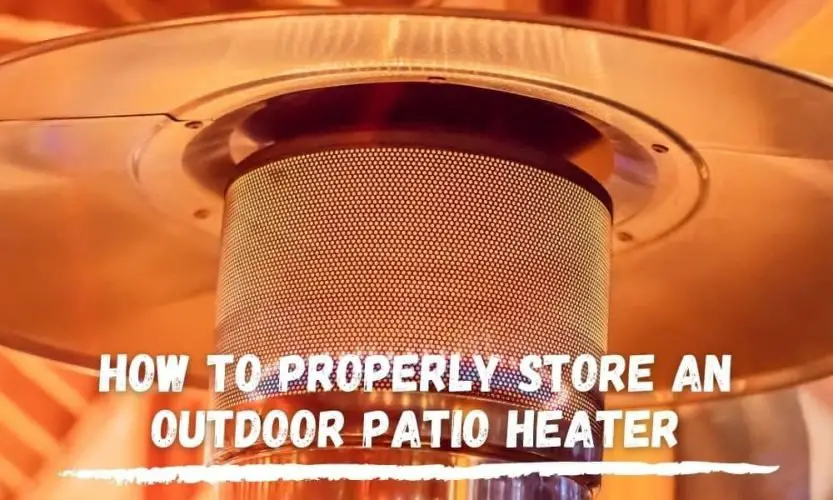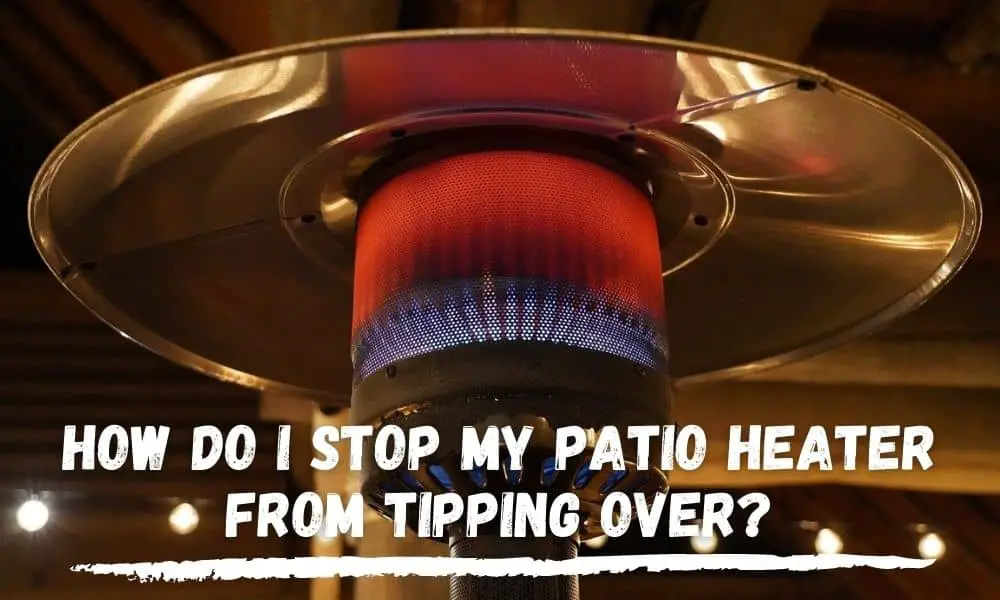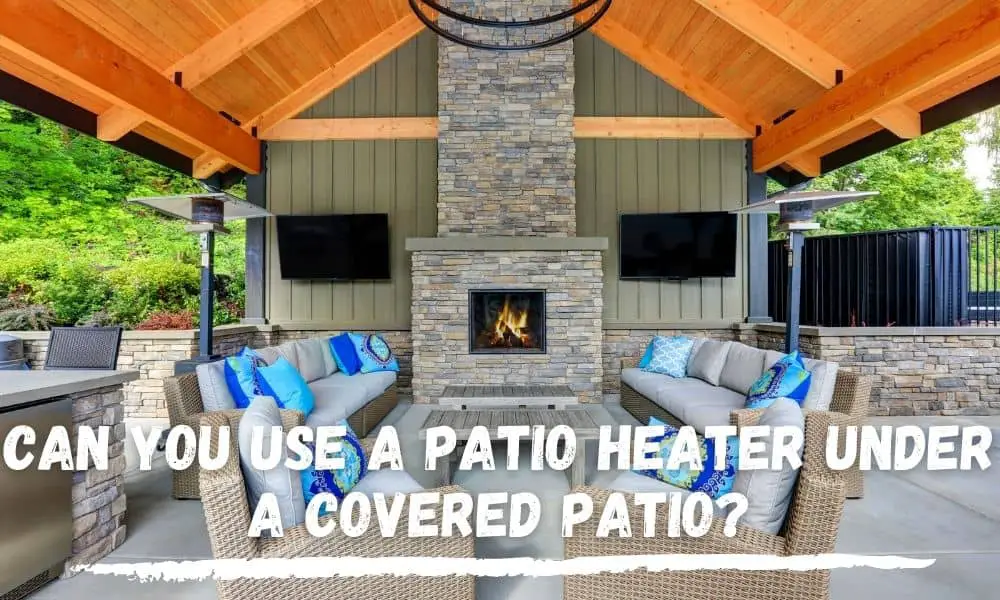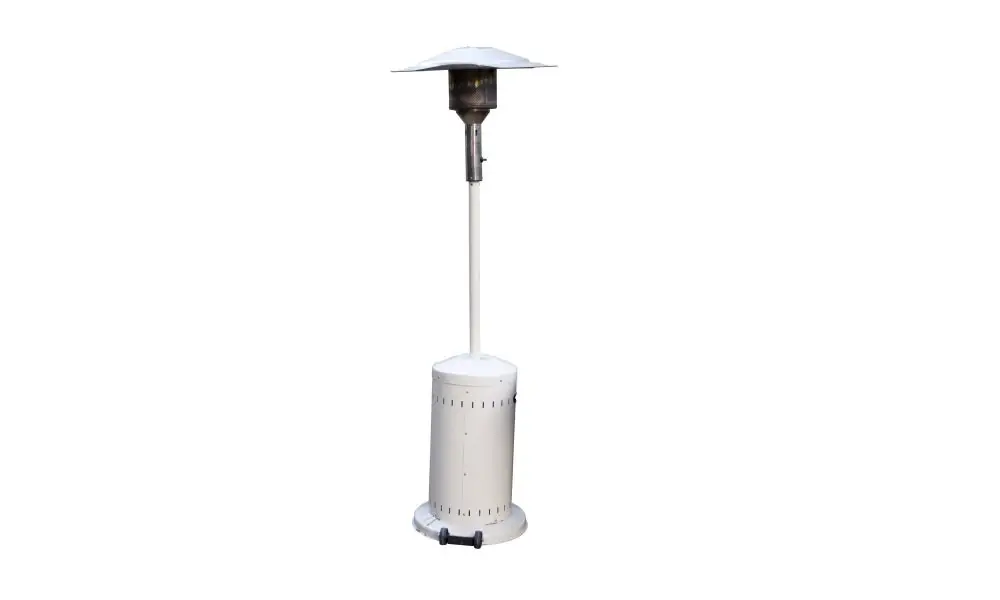The warm ambiance from outdoor heaters is always a welcoming experience when chilling out with friends. However, this may be short-lived if you don’t take specific issues keenly when dealing with outdoor heaters.

Fortunately, our years of experience provide us with adequate knowledge of patio heater care practices.
We will share details about cleaning practices, proper placement and storage positions, and detaching your heater. We’ve also included a guide on covers and stability improvement.
Quick Navigation
- Are Outdoor Heaters Waterproof?
- How Do You Store a Patio Heater?
- Considering the Fuel Type
- The Appropriate Placement Position for Your Patio Heater
- Investing in a Quality Backyard Unit Cover
- Improving Your Patio Heater’s Stability
- Properly Detaching Your Portable Unit
- Determination of an Ideal Storage Point for Your Backyard Unit
- Cleaning the Accessible Patio Heater Parts
- Thermocouple Cleaning Guide
- Pilot Tube Cleaning Guide
- Can Electric Patio Heaters Be Left Outside?
- Conclusion
Are Outdoor Heaters Waterproof?
There are two common words (waterproof and water-resistant). People often use it interchangeably, which is incorrect. When an item is waterproof, it is entirely immune to water effects. On the other hand, a water-resistant product is one that offers partial immunity.
Although many outdoor heaters feature stainless steel construction, they are still not immune to weather damage.
Outdoor space heaters that come from bronze have an even faster corrosion rate than stainless steel ones. Therefore, outdoor heaters are not waterproof, but they have high weather resistance.
How Do You Store a Patio Heater?
There are many issues to factor in for the proper storage of your backyard unit. These include:
- The fuel type. For example, does it require a propane tank or natural gas?
- The appropriate placement position for your patio heater.
- Investing in a quality backyard unit cover.
- Improving your patio heater’s stability.
- Properly detaching your portable patio heater.
- Cleaning the accessible parts.
- Determination of an ideal storage point for your backyard unit.
If you store your outdoor patio heater correctly, it will serve you for a longer time; hence you’ll enjoy its full value. Below is a detailed overview of how to store your outdoor patio heater.
Considering the Fuel Type
The fuel types compatible with outdoor heaters include:
- Propane
- Electric
- Natural gas
- Wood
Each fuel features different storage ways.
You can connect electric heaters to any socket that meets the voltage required. For this reason, electric outdoor heaters are portable. Hence, you can store them more securely.
A natural gas patio heater has a permanent natural gas line connection that needs professional installation. Consequently, you can’t move it around like other heaters. So, storing your natural gas heater is mainly via using covers.
A propane patio heater doesn’t require a fuel connection line. However, moving propane tanks is tedious. Wood-burning outdoor heaters are similar to propane heaters in that they don’t have a fuel connection.
When it comes to wood-burning outdoor heaters, you’ll require much space to store firewood and burn it. If you use propane units or wood-burning ones, you will conduct numerous maintenance practices. These two need more care than electric and natural gas heaters.
The Appropriate Placement Position for Your Patio Heater
Before conducting other backyard heater maintenance practices, the first thing is finding an appropriate placement position. Assume that you won’t move your outdoor patio heater much.
The crucial considerations are;
- Looking at the closeness of your outdoor patio heater to other objects.
- Determining the wind’s strength on where you want to position your outdoor patio heater.
- Determining the stability and firmness of the surface on which you are placing your outdoor patio heater.
- Determining the ease of access and aeration of the area.
Typically, outdoor heaters should have a clearance of at least 3′ around them. While many people maintain these distances, they forget about the area over the backyard heater. Keep the recommended clearance when using patio heaters under covered spaces.
Similar to when using a fire pit, refrain from placing your outdoor patio heater under a tree. Dry leaves can fall into your unit and instantly catch flames. Moreover, pests may make a home out of your outdoor patio heater.
Weather conditions affect the longevity of your outdoor patio heater. Find out which section of your patio receives high winds and which has better wind cover. Wind can result in toppling or blowing flammable materials into the heater.
It may not be easy to detect the areas least affected by wind. However, you can look at the general effect of wind on different sections of your property. You’ll then determine where your heater will have the most protection from it.
A stable and firm ground, such as a concrete slab, is excellent for increasing your heater’s life. Make sure to avoid lawns when using a patio heater as grasses have a rugged surface. This may affect the stability of your backyard heater.
So, your patio heater may topple, leading to breakage or a gas leak. Plus, grass being flammable makes it not the best material to have around an outdoor heater.
Investing in a Quality Backyard Unit Cover
Covering your outdoor heater is one of the most crucial maintenance practices. A high-quality heater cover might be the only way you can properly store some heaters, i.e., natural gas heaters.
Get a waterproof backyard heater cover for the best experience. A waterproof cover will ease cleaning and offer adequate weather protection to your backyard heater.
Remember that not all backyard heater wraps that completely engulf your unit are ideal for you. Find a wrap that correctly fits your backyard heater. The more baggy your patio heater cover is, the more air space it can accommodate.
During strong winds, baggier backyard heater wraps keep flapping in the wind. Consequently, your patio heater may end up tipping over, resulting in damage, gas leakage, or a fire hazard.
Besides a proper fit, find a cover that features air vents. Air vents permit adequate airflow to prevent flapping action. Hence, they ensure that your backyard heater is stable.
Simultaneously, the ample airflow prevents condensation of vapor within the cover walls and on your backyard heater. Therefore, it deters outdoor heater corrosion hence promoting longevity.
Consider tying down your backyard heater cover or bolting it for extra security. This prevents any form of shifting and ensures that your cover won’t topple your backyard heater.
There are numerous quality patio heater covers available today. You can also consider getting a custom-made backyard heater cover for the perfect fit.
Improving Your Patio Heater’s Stability
There are numerous ways to improve the stability of your backyard heater. Some stability-enhancing methods include;
- Base weight increment techniques like using water weights and sandbags.
- Patio heater securing methods with fire-resistant ties, i.e., bungee ropes.
- Bolting your outdoor heater to the ground
Improving your patio heater’s stability enhances its lifespan. You’ll minimize toppling chances hence avoid direct component destruction or indirect via a gas leak fire.
Properly Detaching Your Portable Unit
Numerous patio heaters are detachable. Assembling your backyard heater enhances the cleaning practices you are capable of conducting on it. Moreover, detaching gives you more space to do your activities.
Make sure that your outdoor heater is off before disassembling it. Also, give it time to cool first so that you don’t burn yourself.
Make sure to check your backyard heater manual for instructions on disassembling the heater and utilize it in doing so. Don’t try to do this without checking your manufacturer’s manual unless you are overly familiar with the procedure.
Determination of an Ideal Storage Point for Your Backyard Unit
There is undoubtedly a better place to store your compact patio heater than your usage area. You may place your unit on your outdoor patio for maximum enjoyment and ample protection.
However, the conditions may not be perfect for storing them outside after usage. Rain can destroy your unit irrespective of its build quality.
Consider a place in your garage or house where you can store your unit. Make sure to store your heater away from any liquids and areas like sinks. Also, make sure to wrap it to enhance its protection.
Furthermore, make sure your backyard unit has no connection to a fuel source while you store it. Consider storing your natural gas supply and propane tanks away from your house to avoid a fire hazard.
Cleaning the Accessible Patio Heater Parts
If you are using an electric outdoor heater, you may not need to do a lot of cleaning on it. The only thing you should do is wipe away dust. Insects get attracted to the heat and light emanating from electric outdoor heaters. Hence, you may need to wipe dead ones away too.
If you have a propane or natural gas heater, there are two vital parts to clean.
- Thermocouple
- Pilot tube
If these parts are dirty, you won’t be able to light your backyard heater after storage.
Thermocouple Cleaning Guide
Heaters use thermocouples to ensure that pilot lights stay lit. Without a thermocouple or a faulty one, your fuel valve will close, and your heater will go off.
It functions by permitting current flow when metal gets lit. The heated metal expands, completing the circuit.
Upon cooling, it contracts and breaks the circuit. Dirt on your thermocouple will also deter circuit completion. Many propane and natural gas patio heaters have thermocouples to enhance safety. See our troubleshooting guide for thermocouples.
The things you’ll require to clean your thermocouple include:
- Steel wool
- Dry sponge
- Screwdriver
- Pencil eraser
The Thermocouple Cleaning Procedure
- Shut down your outdoor unit.
- Use the screwdriver for loosening thermocouple screws.
- Remove your thermocouple from your heater’s pilot assembly.
- Rub your thermocouple with steel wool or the rough part of the dry sponge.
- Ensure you rub off all the soot off your thermocouple’s surface.
- Use the pencil eraser to clean the screw threads.
- Reposition it back to your backyard heater.
Make sure you avoid detergents as some may contain flammable ingredients.
Pilot Tube Cleaning Guide
Cleaning your pilot tube ensures the pilot light functions effectively. This facilitates the efficient operation of the main burner.
The materials for pilot tube cleaning include
- Screwdriver
- Alcohol-soaked cotton swab
- Piper cleaner
The Procedure for Pilot Tube Cleaning
- Detach your patio heater’s fuel supply and turn it off.
- Utilize the screwdriver to detach the coupler connected to your gas inlet valve.
- Disengage your outdoor heater’s top cover while following the manufacturer’s instructions.
- Locate your heater’s burner assembly. Use the alcohol-soaked cotton swab to rub its holes.
- Locate venturi tubes (silver-colored and found behind the burner assembly).
- Circularly twist a pipe cleaner, jam it into the tubes, and then pull it out.
- Assemble your patio heater.
- Test to see if it functions properly.
Can Electric Patio Heaters Be Left Outside?
Though you may leave numerous patio heaters outside, it isn’t a good idea. Many patio heaters can withstand a slight drizzle. However, continually leaving them out in the rain hastens their degradation.
When it comes to infrared heaters, you should never leave them outside. When rainwater comes into contact with electricity, it is likely to result in an electrocution accident.
Water naturally absorbs substances that result in its ionization. Consequently, it facilitates electrical conductivity, which may result in electrocution.
However, there are certain cases when it may be an excellent insulator. For instance, distilled and deionized forms feature no solutes that facilitate conductivity. But since it is an outdoor setting, these forms aren’t available.
With the increasing rate of air pollution, rainwater absorbs more gases. Hence, the number of ions in rainwater continually increases, which increases electrocution chances.
Moreover, rainwater corrodes your heater’s parts. Areas close to the coast and those with a high pollution rate will experience faster corrosion.
Insects love to linger around patio heaters because of the heat and lighting. If you leave your electric heater outsider, insects may start living inside your unit.
Electric heaters are generally the lightest patio heaters available. So, it shouldn’t be difficult to store your unit indoors.
Conclusion
Heating patios is enjoyable, more so if you properly store your unit after usage. There are many things you should do to lengthen your patio heater’s life.
Make sure to protect your outdoor heater from unfavorable weather conditions. Position your backyard heater properly to avoid tipping. Finally, clean the accessible heater parts, and you’ll lengthen the time frame of your unit.
We are here to streamline your outdoor experience. Use the contact form on our website for uninterrupted communication.




